How To Repair Something Rust

There is nix worse than knowing rust is eating away at your car. It's the cancer of cars, and if left to run riot it can render any vehicle it takes hold of as nothing more than than scrap. Merely hither'south the thing – cars are protected from rust from the manufacturing plant.
The merely reason information technology sets in later in life is because of utilize or considering damage opens up the door for corrosion. And then you're left to ponder how much a trunk store is going to charge to put it right, to which the answer is commonly: a lot.
Don't panic though. If yous're happy to take a go yourself, the chances are you can stop the rust in its tracks and prolong the life of your dear motor. There'southward really not a lot to information technology. You just need to be thorough, practice the job right and you'll be onto a winner.
At present, before we go into this, a couple of caveats:
We're talking virtually surface rust
If you've got no floors in your car because they've rotted out, you're going to need a professional and a welder. The aforementioned goes for holes in bodywork, sills, chassis runway etc.
What we're looking at here is corrosion to the panels that hasn't eaten through and compromised the structure of the vehicle.
Pigment
In this guide nosotros'll take you right up to point of priming the affected area. If you want to have a go at painting the machine, and so past all ways do. Solid colours are going to yield the best results, while metallics will exist trickier to get correct.
There is no shame in doing the prep piece of work and then request a body shop to pigment it and alloy information technology in. Professional pigment spraying equipment is designed for this – the nozzle of an off-the-shelf aerosol isn't.
How do you ready rust impairment on a auto?
Vehicles today are much less rust-prone than they were simply 20 years ago, but if you lot alive about the ocean or drive in an expanse that uses salt on the roads, you can still get rust through long before the mechanical parts are worn out.
Minor rust harm on non-structural parts of the car can be easily repaired and with a trivial do fifty-fifty made to look similar they never happened.
Professionals restoring classic cars unremarkably employ a method of cutting out the harm and welding in new fabric, but for a daily commuter fibreglass epoxy and a petty body filler makes things much easier.
In by guides we've talked well-nigh fixing a scratch in your car'south paint, just what if a scratch has progressed to the point of rust through?
About rust through damage starts out with something as uncomplicated equally a flake from a slice of flying gravel, or a door ding that cracks the paint, which is why it is so important to give your motorcar a wash and a once over periodically.
A spot of touch-upwardly pigment now then may take a few minutes and save hours of rust repair 10 years from now. Read on for step by step instructions, or check out ourvideo tutorial below.
You'll need the post-obit tools and materials for this chore:
- Angle grinder and flapper wheels
- Wire brush
- Fibreglass epoxy gel
- Body filler
- Various grade sandpaper (80, 400, 600, 1000, 2000)
- Sanding block
- Primer and base of operations coat paint
- 2k clear coat paint (available in aerosol cans)
- Masking materials (paper and record)
- Rubbing compound
- Mineral spirits
- Rags
- Tack cloth
How to remove and repair rust harm on your auto
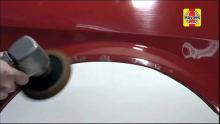
1) Remove Paint and Rust - Employ an angle grinder with flapper wheel to remove the former rust and paint from the surface to be repaired. It is possible to accomplish the aforementioned affair by hand with coarse fourscore grit sandpaper and a wire castor, merely it is much harder to do a thorough job. For an area where you can't reach with the grinder, use the wire castor to remove as much clay, grime, and rust as you tin. Y'all may want to use a rust converter, which goes beyond pigment to chemically neutralise rust and leave a protective black coating.

2) Repair with drinking glass fibre - Long strand glass fibre repair gel, unlike body filler, creates a structural repair that is nearly as strong as steel. Mix the gel and hardener, and press into the damaged area from backside. Check with the package, simply it typically starts to harden in about xv minutes and tin can be sanded in less than an hour.
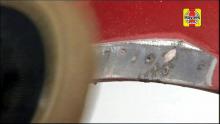
3) Sand excess glass fibre - Use the angle grinder and flapper bicycle to sand off whatever glass fibre gel that has been pushed out through the rust holes. The surface of the hole should be slightly recessed compared to the metallic body panel and so that it tin be filled with the smoother body filler.
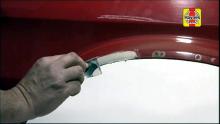
4) Employ body filler - Mix the body filler with the proper corporeality of hardener. Use trunk filler with a flexible, flat spreader, pressing it into the rust holes. The flatter you tin go the filler while applying it, the less sanding you will take to practice later. Be sure to employ enough filler so that at that place are no low spots, pinholes, or scratches that will take to be filled in with a second coat.

5) Sand it smooth - The nearly important and most time-consuming role of body piece of work is getting a smoothen surface before you start applying paint. Start with 400 or coarser grit sandpaper and sand off any excess body filler; it sands faster if it is not quite fully difficult. If sanding a large area, yous may need a sanding cake to make sure you don't end up with a wavy surface. You are done when the entire surface area has been sanded polish to the impact with 400 form newspaper.

6) Clean expanse - Wipe the area you lot simply repaired with a make clean rag and mineral spirits to remove any remainder clay or oil from your fingers. The trunk filler should be so thin you can see metal and paint through it in most places. Allow dry out, and then wipe once once again with a tack fabric to remove whatever lint. Any fingerprint, smudge of oil, or spec of dust will cause spots, fisheyes, or runs in your pigment, so cleanliness is crucial from here on out.
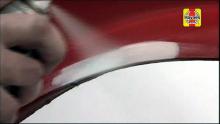
seven) Apply primer - Spay primer over the repaired area, whatsoever blank metal, and at least an inch around it to allow for blending. For best results, spray over the entire area in a thin coat, then go over once more a few minutes later with a slightly heavier coat. Let the primer dry the recommended amount of time before sanding.

eight) Wet sand and repeat - Wet sand the newly primed area with 400 grit sandpaper until information technology is smooth and the edges of the repair are feathered into the original paint. Wipe make clean, allow to dry out and spray another coat of primer. Move to a higher grade of sandpaper, 600, and wet sand and prime again. Two or three coats of primer are typically enough to get a reasonably polish repair.

9) Spay the base coat - Nearly cars these days use a base coat (the color pigment) covered with a protective tiptop coat (a thicker articulate paint), but many bear upon-upward paints can be practical lone without the clear. Spray 2 or three sparse coats of paint over the primer and repaired area, and up into the original paint. Several thin coats are better than 1 thick coat because it avoids leaving runs or drips in the paint.
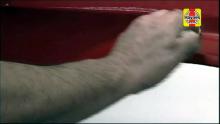
10) Rub out the paint - In order to go the full glossy terminate from spray can bear upon-up paint you need to run it by paw with a rubbing or polishing compound, and if you have whatever pregnant mistakes (orangish skin, runs, drips), yous will need to first with wet sanding. Wet sanding with 1000 and and so 2000 grit should permit you to remove runs and orangish peel, or you may take to go even coarser, but get as well far, and you lot will have to spray another coat of pigment. Polish lightly with rubbing chemical compound, then move up to a finer polishing compound, and you should achieve full gloss. The rubbing will too permit you lot to blend the new pigment of the repair into the original paint around the edges.
eleven) Spray the clear coat (optional) - A articulate glaze is optional for most minor repairs, just the appearance of 2K clear paint in a spray tin has made it a good thought if you plan on keeping the machine. The original manufacturing plant paint uses a two function mixture with paint and an activator or hardener, making the paint like an epoxy that is impervious to weather, UV calorie-free, and solvents. Two part, or 2K, spray paint will make your dwelling house repair nigh as durable every bit a professional body shop paint task, and much longer lasting than bear upon-up paint alone.
We shot a companionrust repair how-to video that quickly and concisely demostrates merely how easy repairing rust in this fashion tin be. If y'all find that video helpful, subscribe to the Haynes YouTube Channel and get more helpful hints, how-tos, and previews of new products.
Source: https://haynes.com/en-gb/tips-tutorials/basic-body-work-repairing-rust-damage-fiberglass-gel
Posted by: joneswarry1979.blogspot.com


0 Response to "How To Repair Something Rust"
Post a Comment